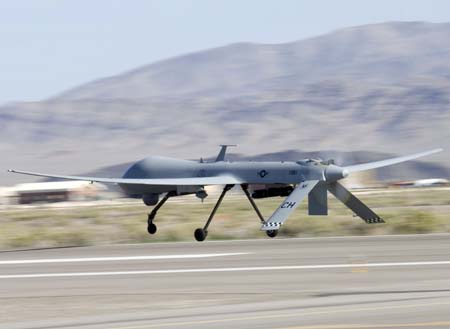The Ai r Force’s MQ-1 Predator unmanned aerial vehicle force amassed 150,000 combat flight hours over the last 14 months, eclipsing the 250,000 hours the Predator had accumulated by June 2007 in its first 12 years of operation. According to an Aug. 19 Air Combat Command release, the 15th Reconnaissance Squadron at Creech AFB, Nev., flew the 400,000-flight-hour mission in operations over Southwest Asia on Aug. 18. The unit’s commander, Lt. Col. Robert Kiebler, said that the 15th RS has taken part in “every major operation” in Iraq and Afghanistan “since the inception of combat operations.” According to Col. Christopher Coombs, commander of the Aeronautical Systems Center group that procures the MQ-1, the Predator force now is flying “about 14,000 hours a month.” Since 1998, his unit has fielded 165 MQ-1s to meet ever-increasing demand. (To help meet that demand, the Air Force also plans next year to open a second UAV training center in addition to Creech.) Col. Chris Chambliss, commander of the 432nd Air Expeditionary Wing at Creech, praised the entire Predator team—airmen at Creech and at Air National Guard bases—who are “grinding it out to continue to fight over Iraq and Afghanistan every hour of every day.” (ACC report by SSgt. Thomas Doscher)
r Force’s MQ-1 Predator unmanned aerial vehicle force amassed 150,000 combat flight hours over the last 14 months, eclipsing the 250,000 hours the Predator had accumulated by June 2007 in its first 12 years of operation. According to an Aug. 19 Air Combat Command release, the 15th Reconnaissance Squadron at Creech AFB, Nev., flew the 400,000-flight-hour mission in operations over Southwest Asia on Aug. 18. The unit’s commander, Lt. Col. Robert Kiebler, said that the 15th RS has taken part in “every major operation” in Iraq and Afghanistan “since the inception of combat operations.” According to Col. Christopher Coombs, commander of the Aeronautical Systems Center group that procures the MQ-1, the Predator force now is flying “about 14,000 hours a month.” Since 1998, his unit has fielded 165 MQ-1s to meet ever-increasing demand. (To help meet that demand, the Air Force also plans next year to open a second UAV training center in addition to Creech.) Col. Chris Chambliss, commander of the 432nd Air Expeditionary Wing at Creech, praised the entire Predator team—airmen at Creech and at Air National Guard bases—who are “grinding it out to continue to fight over Iraq and Afghanistan every hour of every day.” (ACC report by SSgt. Thomas Doscher)
The Space Development Agency says it’s on track to issue its next batch of missile warning and tracking satellite contracts this month after those awards were delayed by the Pentagon’s decision to divert funds from the agency to pay troops during this fall’s prolonged government shutdown.

